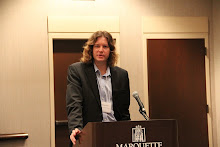I have had the pleasure of teaching an aesthetics course to students at a college of art and design for the last two years. I am also just finishing up teaching an "Ethics in the Arts" course this semester. The first course consists, generally, of artists and designers while the second has been made up of mostly non-artists.
I find that teaching artists poses fairly unique challenges. On the one hand they tend to be very passionate and committed to what they do, which is not necessarily true of standard college students. This presents a wonderful opportunity. If you can somehow connect to their passion, and channel that interest towards the topics and authors you are teaching, you can end up with an exceptionally engaged group of students.
On the other hand artist tend to be focused on what they make to the exclusion of other interests. For example, often I find that they originally don't have much interest in questions about the larger meaning or history of what they produce. They make what they make, they like what they like, and at first this seems to them to be perfectly sufficient. In this situation, when you introduce them to the history of the philosophy of art, the fairly common response tends towards defensiveness and resentment. Who are these random intellectuals and philosophers, the students wonder, to tell artist what they should or shouldn't make or how their work is to be judged? This is, in my opinion, an absolutely justifiable attitude.
We can convince artist to care about philosophy of art in several fairly obvious ways. Clearly, if they hope to be professional artist or designers, their success is going to depend on the critical responses of others and these responses are going to be informed by theory drawn, in most cases, from a fairly standard collection of starting philosophical positions. Also, the history of thought concerning art can provide artists with the inspiration to develop in new and unexpected directions. Warhol, for example, would never have even thought of many of his works without the grounding in the history and philosophy of art which influenced his activities. What he was providing, in many ways, was a commentary and response to the history of thought about art.
Probably the most interesting and important reason for artists to study philosophy of art, however, has to do with their relation to their influences. We are, whether we know it or not, influenced by the traditions and practices in which we find ourselves. These influences can be passively accepted by us with little or no knowledge on our parts of their origin and meaning. On the other hand, these influences can be made conspicuous to us through a study of the history of thought. Once these influences are clear to us we can take a more active stance in response to them, playing some of them off against others or seeking new influences through which to weaken or change previous ones. The key is recognizing that influence is inevitable and inescapable. The choice we are left with is whether we will be passive and ignorant in the face of influence or active and aware.
I draw here on the literary critic Harold Bloom's discussion of influence and strong misreadings which Richard Rorty has also put to work. Bloom suggests that fear of influence is one of the most basic forces that work upon the creative activity of artists in general, although he tends to focus upon the literary realm that is his main domain of interest. As influence is actually inescapable, the main strategy to free oneself from influence which Bloom discovers in the history of literature is the use of the strong misreading. In a strong misreading we take our influences and actively gain some control over, and thus freedom from, them through creatively rereading or insightfully rediscovering them. What we see here is something rather similar to the concept of redeeming the past we find in Nietzsche. The past is redeemed by giving it new meaning in relation to contemporary purposes and concerns. In this sense, to borrow from Foucault, every history becomes a history of the present, an effective history aimed at changing the present and future through a re-evaluation of the past.
The web of influences can be played with but never destroyed, rereading or misreading will itself be an influenced endeavor. It is, as I formulated it earlier, a case of actively playing influences one against the other. To do so, however, requires an ever deepening understanding of the history and vicissitudes of the practices, traditions and philosophies in which we find ourselves.
I believe this to be the most valuable contribution that the study of philosophy of art offers artists themselves. It should be clear, however, that we all find ourselves in this relation to influence. In general, then, this is also one of the strongest justifications for the study of philosophy generally. An active and clear-sighted relation to influence is surely a prerequisite for freedom and rationality, however we may conceive of these.
Saturday, April 17, 2010
"Teaching Philosophy of Art to Artists" or "The Issue of Influence"
Labels:
aesthetics,
art,
Bloom,
Definitions of philosophy,
Foucault,
Influence,
Nietzsche,
Rorty
Subscribe to:
Post Comments (Atom)


No comments:
Post a Comment